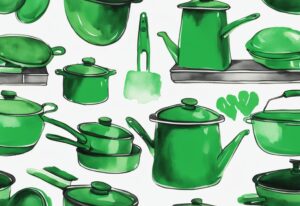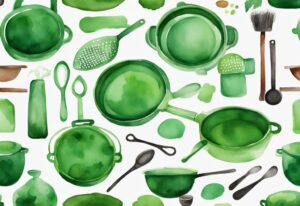Discover the Process: How is Organic Tea Made from Scratch?
Ever sipped on a cup of organic tea and wondered about the journey it takes from the earth to your teacup? Hi there, it’s Olivia from nontoxicways.com and I’ve been exploring the fascinating world of organic tea production. Allow me to take you down a path less trodden, as we delve into the natural farming practices and chemical-free methods used to create your favourite brew. Uncover the numerous benefits of organic tea, not only for your health but also for our shared environment. In this article, we look at how organic tea is made, debunking myths and revealing the truth behind your delicious cup of solace. Cheers to conscious living, one sip at a time.
What Makes Organic Tea Organic?
To truly appreciate organic tea, it’s essential to understand the principles that define its cultivation. These practices ensure the tea you enjoy is not only delicious but also nurturing for our planet.
The Principles of Organic Farming for Tea
Natural Pest Control Methods
One of the foundational practices in organic tea farming is the use of natural pest control methods. Farmers dedicated to producing organic tea prioritize the health of their crops and the environment by avoiding synthetic pesticides. Instead, they embrace natural predators, biological controls, and organic sprays, which are essential components of effective pest management in organic farming practices, as detailed by the Rodale Institute.
This method is beautifully simple yet profoundly effective. Encouraging beneficial insects to manage pest populations helps maintain ecological balance. I’ve seen firsthand how avoiding synthetic chemicals prevents soil and water contamination, creating a healthier environment for both plants and local wildlife.
Use of Organic Fertilizers
Organic fertilizers, like compost and manure, are the heart of organic tea farming. These natural fertilizers enrich the soil with essential nutrients critical for healthy plant growth. In stark contrast to synthetic fertilizers, which can harm soil structure and leach chemicals into the environment, organic fertilizers bolster soil fertility without adverse effects.
I remember visiting a tea farm where the vibrancy of the plants was a testament to the power of organic nourishment. Using organic fertilizers, farmers ensure not only the robust growth of tea plants but also the sustained health of the soil, promoting long-term productivity and ecological harmony.
Soil Enrichment Techniques
Creating superior quality organic tea starts with enriching the soil. Farmers employ methods such as crop rotation and composting to foster soil health.
Crop rotation involves planting different crops in succession on the same land, breaking pest and disease cycles while boosting soil fertility.
I can’t overstate the significance of composting. Adding valuable organic matter back into the soil enhances its nutrient profile and structure. These natural techniques are essential for retaining soil moisture and preventing erosion. Witnessing these practices at work, I’ve seen the resilience and fertility enhanced in tea plantations, ensuring that organic tea farming remains sustainable and capable of producing exquisite tea leaves.
By focusing on soil health, organic tea cultivation not only yields higher quality tea but also supports long-term environmental sustainability.
Choosing the Right Tea Plants for Organic Production
Understanding Hearty and Disease-Resistant Varieties
Selecting the appropriate tea plant varieties is crucial when understanding how organic tea is made. Farmers look for robust, disease-resistant plants to minimize the need for chemical interventions. The plant varieties chosen must withstand various environmental challenges while remaining productive.
Organic tea cultivation relies heavily on plants that naturally fend off common pests and diseases. By opting for these resilient varieties, farmers can avoid synthetic pesticides and fungicides. These natural defenses play a significant role in maintaining the health of the tea plants and the surrounding ecosystem.
Small independent farmers often prioritize these hardy varieties to preserve the authenticity of their organic practices. The selection process involves extensive research and sometimes trial and error, ensuring that the chosen plants can thrive without artificial aid. Robust plants tend to have deeper root systems, which not only contribute to their resilience but also help in nutrient absorption, leading to richer and more flavorful tea leaves.
Being meticulous about plant choice is a fundamental step in how organic tea is made. Through careful selection, farmers reinforce their commitment to organic authenticity, ensuring that each leaf contributes to a sustainable and non-toxic tea production process. This method not only enhances the quality of the tea but also promotes biodiversity and environmental health.
The Art of Harvesting Organic Tea Leaves
Harvesting organic tea leaves is a meticulously curated process that hinges on traditional methods and precise timing, ensuring that every cup you enjoy is rich in flavor and quality.
Hand-Plucking Technique: Keeping it Personal and Organic
Hand plucking is a cornerstone in the methodology of how organic tea is made. This traditional technique ensures only the youngest and highest quality tea leaves are selected. By avoiding mechanical harvesting, the delicate tea leaves maintain their integrity, significantly enhancing the overall quality of the tea. Local workers are employed to meticulously pluck the leaves by hand and collect them in wicker baskets. This artisanal approach not only preserves the freshness and natural integrity of the leaves but also supports the community by providing sustainable employment opportunities.
Hand plucking is truly the heart of organic tea making. This time-honored method ensures that only the youngest and most vibrant leaves make it to your teacup. Mechanical harvesting might seem efficient, but nothing compares to the gentle touch of skilled hands delicately selecting the perfect leaves.
Imagine the serene landscapes where local workers, armed with bamboo baskets, move gracefully among tea bushes. Each plucked leaf retains its natural essence, waiting to be transformed into the soulful tea you cherish. More than just a method, this is a tradition that sustains local communities, offering meaningful employment while upholding the integrity of organic tea.

When is the Perfect Time to Harvest?
Timing is crucial in how organic tea is made, as it significantly influences the tea’s flavor and aromatic profile. Different types of tea—green, black, oolong—require specific harvesting periods to ensure their unique characteristics are captured. For instance, the best time to harvest green tea leaves is typically during the early spring when the leaves are tender and flavorful. The optimal times for harvesting can vary, but one common practice is to collect the leaves early in the morning. This timing helps to capture the peak aroma and flavor, as the morning dew has freshened the leaves and increased their natural fragrance. By adhering to these meticulous harvesting practices, organic tea producers can guarantee a product that is rich in taste and quality.
Understanding the perfect time to harvest is like knowing the secret ingredient in a cherished family recipe. For those concerned about hair care, one might wonder, “Is Native bad for your hair?” It’s important to look into various products and practices to maintain overall health. The timing sets the stage for the flavors and aromas that will eventually unfold in your cup. Each variety of tea—be it green, black, or oolong—demands a unique harvesting schedule to encapsulate its distinct essence.
Take green tea, for instance. The early springtime is its moment of glory. As the first rays of spring sunlight kiss the tender leaves, their flavor profile becomes irresistible. Collecting these leaves early in the morning, when the dew still lingers, elevates the tea’s natural fragrance and taste.
This nuanced timing isn’t just about tradition; it’s about capturing the very soul of the tea. By adhering to these carefully observed practices, organic tea producers ensure that what ends up in your cup is a symphony of nature’s finest attributes, lovingly nurtured and perfectly timed.
Processing Without Chemicals: How Organic Tea Leaves Are Transformed
Withering: The Natural ‘Dry Out’ Process
Withering is a crucial first step in the process of how organic tea is made. This method involves spreading out freshly picked tea leaves to naturally dry for several hours. By reducing their moisture content, the leaves soften, preparing them for subsequent stages. During this phase, enzymatic activity begins, setting the stage for the development of the tea’s flavor and aroma. This gentle and natural drying approach ensures that the unique characteristics of the leaves are preserved without any chemical intervention.
Rolling: Allowing the Flavors to Blossom
The rolling phase is where the leaves are physically manipulated to release their essential oils, an integral part of how organic tea is made. By breaking the cell walls, the leaves’ natural juices are freed, which helps shape the leaves and intensifies their flavors. This step is vital as it significantly contributes to the tea’s final appearance and taste profile. The rolling process varies depending on the type of tea being produced, but the emphasis remains on maintaining the leaves’ natural quality.
Oxidation: Nature’s Way of Enhancing Taste
Oxidation is a transformative step that distinctly affects both the flavor and color of the tea. Controlled exposure to oxygen allows natural chemical reactions to occur within the leaves. This process is carefully monitored to achieve the desired taste profile, which is a fundamental aspect of how organic tea is made. Depending on the level of oxidation, the tea can turn into black, oolong, green, or white tea.
Green, Black, Oolong, and White Teas: The Organic Twist
For green and white teas, oxidation is kept to a minimum through techniques like sun-drying, pan-firing, or steaming. These methods preserve the fresh, grassy flavors. Black tea undergoes full oxidation, resulting in a robust and dark brew. Oolong tea sits between green and black tea in terms of oxidation, offering a delicate balance of taste and aroma. Each method ensures the natural goodness and unique attributes of the tea are preserved without the use of chemicals.
Firing: The Final Step to a Perfect Organic Tea
Firing is the concluding step in the organic tea-making process, further defining how organic tea is made. This phase involves heating the leaves to halt oxidation, locking in the desired flavors and reducing moisture content. Through methods such as pan-firing, roasting, or steaming, the leaves develop a distinct taste and shelf stability. Firing not only enhances the flavor but also ensures that the tea can be stored without compromising its quality. This crucial step guarantees the delivery of a pure and flavorful cup of organic tea.
Ethical Production: Ensuring Quality and Sustainability in Organic Tea
When it comes to the creation of organic tea, maintaining ethical production standards is crucial. From the sourcing of ingredients to the final packaging, every step in the organic tea-making process must reflect a commitment to sustainability and quality.
What it Takes to be LEED-Certified
LEED (Leadership in Energy and Environmental Design) certification is a crucial milestone for any organic tea production facility. Achieving this status means the facility has committed to the highest standards in efficient and sustainable practices.
For instance, LEED-certified facilities stand out in waste management. They prioritize recycling and composting organic materials, effectively minimizing contributions to landfills. Energy usage is also a significant focus. These facilities invest in energy-efficient machinery and renewable sources like solar panels.
Water usage is another area of meticulous control. Advanced systems collect and recycle water within the facility, significantly reducing overall consumption. By adhering to these stringent standards, LEED-certified facilities exemplify environmental responsibility, reinforcing their commitment to producing authentic organic tea.
Using Mountain Spring Water in Organic Tea Production
The use of pure mountain spring water is pivotal in organic tea production, enhancing both quality and integrity. This pristine water source, free from contaminants and rich in natural minerals, ensures the tea plants receive optimal nourishment.

Moreover, harvesting mountain spring water sustainably supports the preservation of critical natural resources. The purity of this water directly impacts the flavor profile of the tea, producing a vibrant and authentic beverage.
This practice not only preserves the environment but also guarantees that you enjoy a cup of tea imbued with the natural essence of organically grown tea leaves. The journey to creating organic tea is a testament to sustainable practices that benefit both the planet and your palate.
- LEED-Certified Facilities: Ensuring Environmentally Responsible Production
- Mountain Spring Water: Preserving Purity for Vibrant Flavor
Organic Tea Certifications and Standards: What to Look For?
Exploring the certifications and standards for organic tea offers valuable insights into how organic tea is made. Each certification is not just a label but a testament to the rigorous practices followed to ensure the tea adheres to the highest organic principles.
Understanding USDA Regulations on Organic Products
- The USDA certification for organic tea is more than just a stamp. It’s a guarantee that your tea has been grown and processed with utmost care, free from synthetic chemicals like pesticides, fertilizers, and other agricultural chemicals common in conventional farming. I vividly remember my first experience with USDA-certified organic tea — every sip felt purer, as if I was savoring nature itself.
- Achieving USDA certification also means that organic tea producers must ensure their products are free from genetically modified organisms (GMOs). This rigorous oversight involves strict verification processes, ensuring each step from soil preparation to leaf harvesting aligns with organic standards. This dedication ensures that the tea in your cup is truly organic.
- The USDA’s organic regulations encompass a range of farming practices critical to understanding how organic tea is made. These include sustainable methods like crop rotation and compost usage. Each farm is meticulously inspected and must maintain detailed documentation. I once visited an organic tea farm where the air was buzzed with vitality — a testament to the farm’s commitment to ecological balance.
- It’s essential to understand that USDA certification also governs the handling and processing of organic tea. This means at no stage, from the tea fields right to your pantry, can any synthetic or harmful substances be introduced. For anyone who values purity, USDA organic certification is a beacon of assurance.
- Beyond exclusion, the organic approach actively promotes biodiversity and soil health. This not only makes the tea safer but often enhances its nutrient content. The holistic way in which organic tea is made is reflected in its rich taste and aroma, carrying a lighter environmental footprint. Drinking a cup of organic tea, I feel a deep connection to nature’s rhythms.
FAQs on Organic Tea Production
How does organic tea differ from non-organic tea?
Organic tea is cultivated using natural farming methods that avoid synthetic pesticides, fungicides, and fertilizers. This approach helps maintain ecological balance and soil health.
In contrast, non-organic tea may involve chemicals that can harm health and the environment, resulting in residual chemicals in the final product.
Why is organic tea considered healthier?
Organic tea is often seen as a healthier option because it contains higher concentrations of beneficial flavonoids and antioxidants. The absence of harmful chemicals ensures that the tea is purer and safer for consumption.
This purity contributes to potential health benefits without the risks linked to synthetic chemicals.
What are the main certifications for organic tea?
When seeking organic tea, look for USDA Organic Certification as a primary indicator of quality. Other recognized certifications include EU Organic, Japan Organic, and COS (Canada Organic Standard).

These certifications ensure the tea meets stringent organic farming standards globally.
Can organic tea be Fair Trade certified?
Yes, organic tea can also hold Fair Trade certification. This certification ensures that ethical labor practices are followed, guaranteeing fair wages and working conditions for farmers.
Combining organic and Fair Trade certifications supports both environmental sustainability and social responsibility.
Conclusion
Organic tea production is a harmonious blend of natural farming techniques and ethical practices. By focusing on sustainable methods, farmers ensure that the ecosystem remains balanced and the soil retains its health and fertility. This meticulous process yields a high-quality beverage that is both delicious and beneficial for health.
Understanding how organic tea is made involves recognizing the commitment to avoiding synthetic chemicals throughout the cultivation and processing stages.
This begins with the use of natural pest control methods, where organic farmers employ natural predators and biological controls instead of harmful pesticides and fungicides. Organic fertilizers such as compost and manure enrich the soil, providing nutrients without the adverse effects of synthetic alternatives. Techniques like crop rotation and composting further enhance soil health, ensuring that the tea plants thrive in a fertile environment.
The journey of how organic tea is made continues with the careful selection of tea plant varieties. Farmers often choose robust, disease-resistant plants that require minimal intervention, staying true to organic principles. The art of harvesting plays a crucial role as well. Traditional hand-plucking methods ensure only the best leaves are selected, maintaining their integrity and freshness.
Processing organic tea without chemicals is integral to maintaining its purity. Leaves undergo natural withering to reduce moisture, followed by rolling to release essential oils. Controlled oxidation refines the flavor and appearance of the tea, and final firing stops the oxidation process while enhancing taste and quality.
The dedication to ethical practices extends beyond farming techniques. Many organic tea producers aim for LEED certification, incorporating sustainable operations and preserving resources. The use of natural mountain spring water further underscores the commitment to purity and quality in organic tea production.
In conclusion, organic tea is a testament to the power of natural, sustainable farming. By prioritizing ecological balance, soil health, and avoiding synthetic chemicals, producers deliver a superior product that is healthier for consumers and better for the planet.
This thoughtful approach to how organic tea is made ensures that each cup is a celebration of nature’s bounty and human dedication to non-toxic living.
Hi, I’m Olivia Green, the voice behind nontoxicways.com. I’m passionate about helping you make the shift to a healthier, non-toxic lifestyle without feeling overwhelmed. I love sharing my personal journey, from small changes to big transformations, along with practical tips that make it all feel doable. My goal is to inspire and guide you toward a lifestyle that benefits both your well-being and the planet. Let’s take this journey together, one simple step at a time!














Post Comment